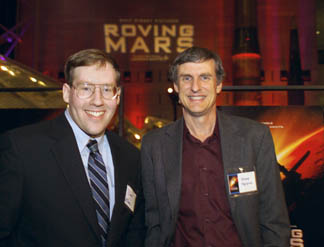'Roving Mars' is part drama, part suspense and all a tribute to NASA team
By Lauren Gold

The IMAX movie, "Roving Mars," which had its world premiere in Washington, D.C., yesterday (Jan. 26), is part detective story, part drama, part suspense.
It begins with the central mystery -- was Mars ever capable of supporting life? -- and continues through the mission's meticulous planning and testing phases. It shows launch day for the Mars rover Spirit on a sunny day at Cape Canaveral in June 2003, and the day, seven months and 300 million miles later, when the rover entered the Martian atmosphere, dutifully deploying parachutes and airbags and bouncing and rolling to a stop.
Then the suspense, as for a few agonizing minutes the rover communicates nothing to the mission's operators at the Jet Propulsion Laboratory in Pasadena, Calif. All that can be heard are the tense words: "We currently do not have a signal from the spacecraft. Please stand by."
Until the signal finally comes, and the room erupts. And the thrill spills beyond the IMAX screen and into the audience.
The premiere of Disney's "Roving Mars" at the Lockheed Martin IMAX theater at the Smithsonian Air and Space Museum was an evening of celebrating two teams: the 4,000 scientists, engineers and support staff who made NASA's Mars Exploration Rover mission a success -- and the smaller group that coalesced on the side to document the mission for the IMAX film.
The celebrities at the event included Steve Squyres, Cornell astronomer and the mission's principal science investigator; Hollywood director George Butler; producer Frank Marshall; and a host of NASA and Lockheed Martin officials. All ambled down the red carpet to the museum's atrium, accessorized with movie posters, tables of appetizers and two talking (and more than a little impertinent) robots, both named Sprocket.
Inevitably there was also a model of the Mars rover, presiding on a platform at the entrance -- the model built by Cornell students four years ago and now permanently on display at the Smithsonian.
If there was another star of the evening, it was the quiet-mannered Dan Maas, animator and Cornell alumnus behind 12 of the film's 40 minutes. Maas' work -- seamless, indistinguishable from the film's actual footage of the mission and filled with true-to-Mars details -- earned him raves from Butler and Squyres. Marshall -- meeting Maas in person for the first time on the red carpet before the film, blurted, "Oh my gosh, let me hug you," He called Maas, "One of the most talented men I've ever met."
Milling around Maas outside the theater after the film, admirers couldn't say enough. "Beautiful," "Amazing," "Stunning," they said. "You really brought it to life."
By the time the audience of media and guests from Cornell, NASA and Lockheed Martin settled into their seats in the steeply raked theater, the mood was set.
The ultimate success and longevity of both rovers, Spirit and Opportunity, still plugging along on opposite sides of Mars two years after their landing, makes the story even more compelling. But producer Marshall admitted it put him in a bit of a quandary.
The story he pitched to Walt Disney Co. was much more straightforward: "They're born, they go up there and rove around, and they die," he said. When they didn't die, no one was quite sure how to proceed. "We said, we've got to figure out another ending. [Spirit and Opportunity] have gone the distance -- way beyond our wildest dreams," he recalled.
As the evening wound down, the thrill of the whole endeavor -- "an interplanetary hole-in-one," as Squyres had characterized Opportunity's landing in Eagle crater on Jan. 24, 2004 -- stuck.
NASA administrator Michael Griffin expanded on the theme "People talk about teamwork -- about people pulling together to get a touchdown," Griffin said. "This was like 10 touchdowns.
"To the success of Spirit and Opportunity, and the people who operate the rovers, both of whom refuse to quit."
Media Contact
Get Cornell news delivered right to your inbox.
Subscribe